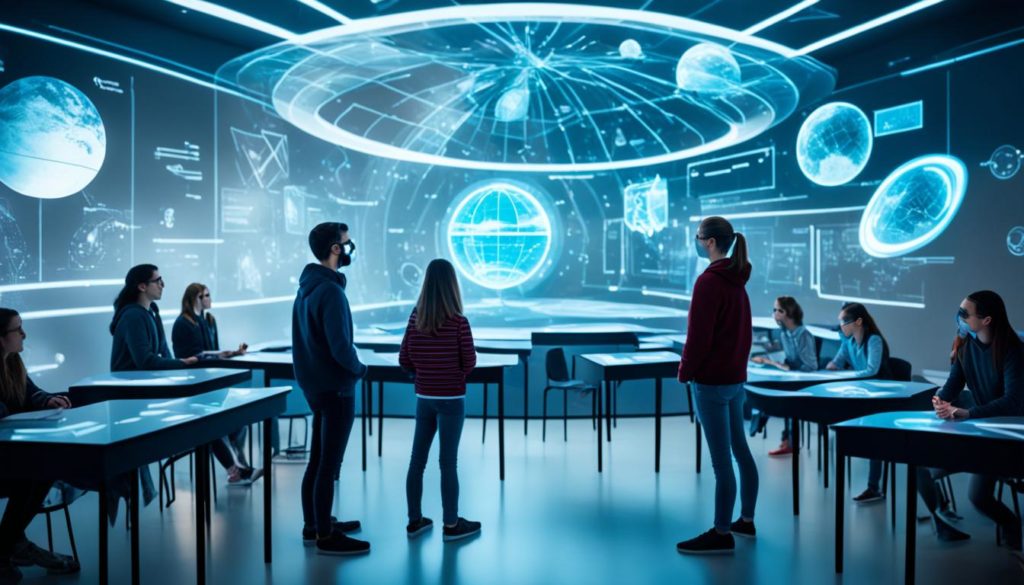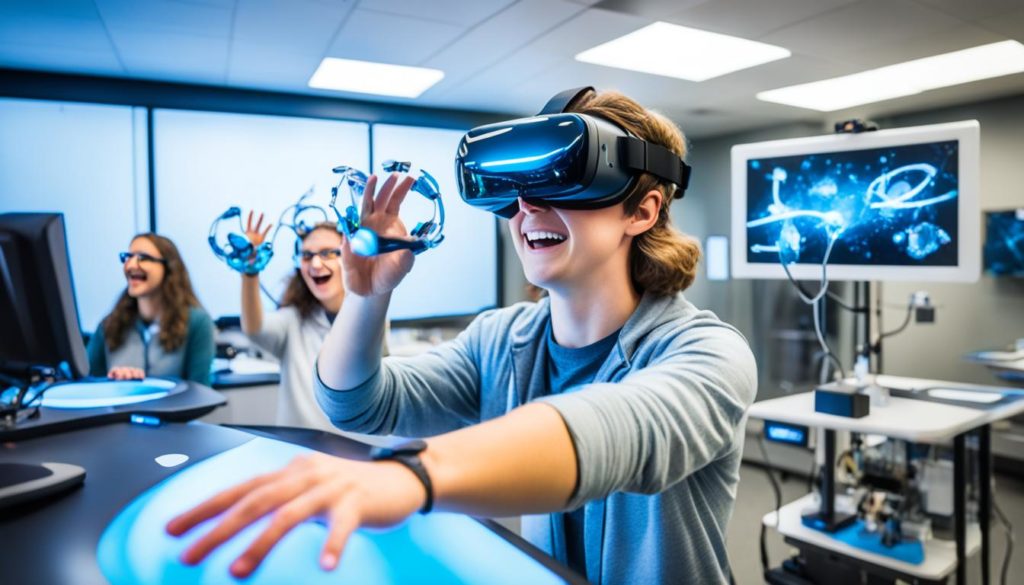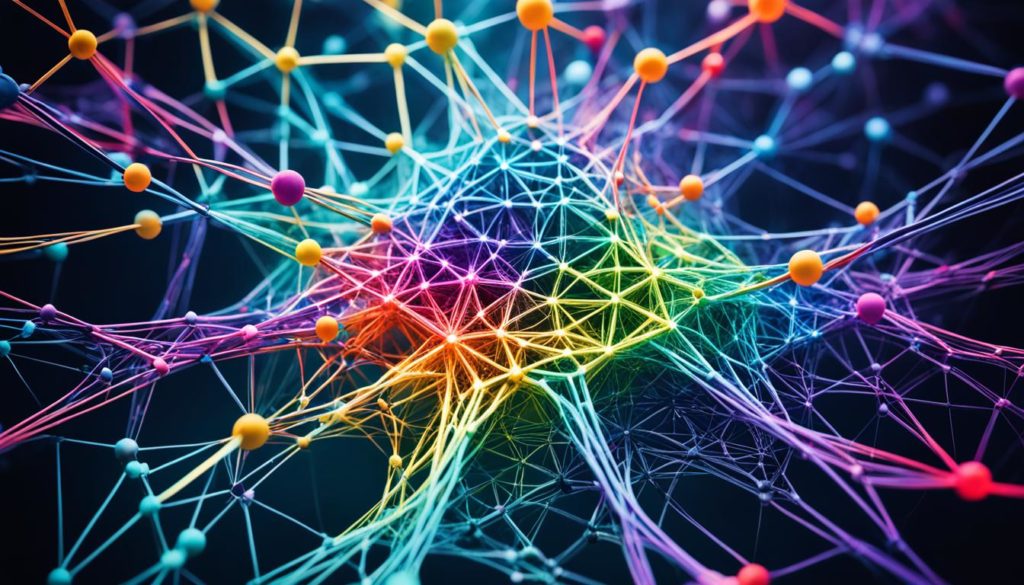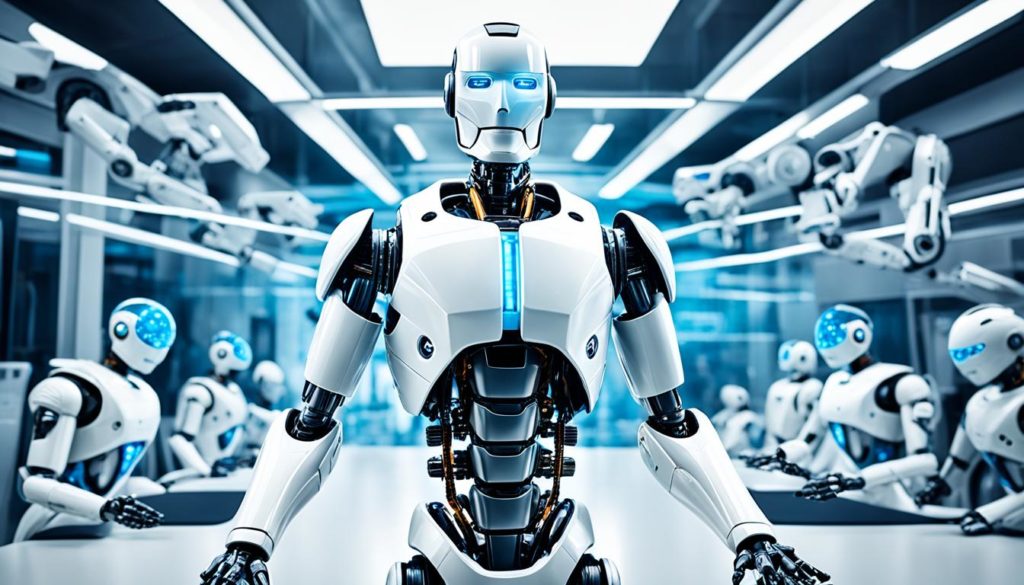
By 2023, the global educational technology market is set to reach a huge $404 billion. As we enter the 2022-2023 school year, education’s digital change is more than tool swapping. It’s a new way to teach and learn. Educational technology trends are shaping the future, making learning more engaging and tailored for students.
Cloud-streaming apps like Adobe Creative Cloud and Autodesk are changing the game. They let students access tools from anywhere, breaking down walls to technology. Schools are upping their game in cybersecurity to protect against threats. Also, exciting techs like AR, VR, AI, and REAL are entering classrooms. These advances, along with personalized and game-based learning, are creating new education models focused on students.
Key Takeaways
- The educational technology market is expected to hit $404 billion by 2023.
- Cloud-streaming applications are democratizing access to essential educational tools.
- Enhanced cybersecurity measures are becoming a priority in K-12 education.
- Innovative technologies like AR, VR, AI, and REAL are finding their way into classrooms.
- Personalized and game-based learning are reshaping student experiences.
Integrating Artificial Intelligence in Education
Artificial intelligence is changing how we learn and teach. It brings innovative solutions to the classroom. With AI, teaching becomes more engaging and effective for everyone.
Personalized Learning Paths
AI changes education by making learning personal. It uses data to create lessons that meet each student’s needs. Carnegie Learning uses AI to adapt lessons for better learning. This tech also helps find students who need extra help.
Virtual Tutors
AI creates virtual tutors that guide students. These tutors make learning interactive and provide real-time help. They understand student questions with natural language technology. This helps improve outcomes and saves teachers’ time by making content.
Data-Driven Insights
AI uses data to make learning better. It tells teachers how students are doing. For example, Brainly uses AI to understand students’ progress. But we must use student data carefully to help, not harm.
The latest research shows AI’s big impact on education. As AI grows, we must deal with issues like privacy and cheating. Working with AI, teachers can make learning better for all.
| Application | Benefit |
|---|---|
| AI Algorithms | Personalized learning experiences |
| Predictive Analytics | Early intervention for at-risk learners |
| Natural Language Processing | Automated language assessments |
| Learning Analytics | Insights into performance and engagement |
| Automated Content Creation | Saves time for educators |
Adoption of Virtual and Augmented Reality
AR and VR technologies are fast changing how we use virtual reality in schools. They let students enter a new world of learning, making hard topics easier and more fun. Now, schools can turn education into an adventure.
Virtual Field Trips
Students can now visit places around the world from their desks thanks to virtual field trips. With tools like Google Expeditions, they can explore ancient ruins, thick jungles, or even space. It’s like a field trip, but with no need for buses or permission slips.
Enhanced Laboratory Experiences
AR and VR are changing how students do lab work. With Labster, they can try out experiments in a safe, virtual space. This cuts down on costs and makes learning deeper and more engaging.
More people can use AR and VR thanks to new devices. Colleges are starting to use these tools more, but they need to think it through. They should plan well and set up rules to make the most of AR and VR.
Want more info on AR and VR in schools? Check out this in-depth piece on future prospects and considerations for AR and VR in. For a deeper look at recent trends, here’s an analysis on AR and VR developments in education.
| Application | Description |
|---|---|
| Google Expeditions | Interactive virtual field trips to global landmarks and unique locations. |
| Labster | Virtual lab simulations offering safe and immersive experimental environments. |
| Microsoft HoloLens | Augmented reality headset for creating interactive, holographic learning experiences. |
| Zappar | Augmented reality platform that brings educational content to life through interactive visuals. |
To really change learning, schools must think carefully about using AR and VR. They face challenges, like the cost of gadgets and the need for good platforms. But if done right, AR and VR could open up new worlds of learning.
Expansion of Cloud-Based Learning Tools
Cloud technology is changing how we learn digitally. It lets students easily use lots of learning tools online. This change improves access and efficiency in learning. A great example is the itopia CloudApps Classroom. This tool brings cloud services straight into classrooms, making a secure and easy space for learning.
Using these tools cuts down costs and complexity seen in old tech setups. Cloud learning is pushing schools towards a sustainable, high-performing tech setup. It’s important now to plan well to keep these systems effective and lasting.
| Aspect | Traditional Learning Tools | Cloud-Based Learning Tools |
|---|---|---|
| Accessibility | Limited to physical hardware | Accessible from any device with internet |
| Cost | Higher due to hardware and maintenance | Lower, with reduced tech management costs |
| Scalability | Difficult and expensive | Easy and cost-effective |
| Maintenance | Requires physical IT support | Managed remotely via the cloud |
Cloud-based learning is shaping a brighter future for education. By using advanced cloud technology, we guarantee a better learning journey for every student. It’s about making education more sustainable, reachable, and efficient for all.
Greater Emphasis on Cybersecurity in Schools
The digital world is growing, and with it, the importance of school cybersecurity. Last year, 1 in 4 schools were hit by cyberattacks. This shows the big risks in our education system. Now, schools are stepping up their game to create safe digital learning environments.
Tools like Multi-factor Authentication (MFA) and Single Sign-On (SSO) are key for better security. They help keep a close eye on who gets in, protecting students’ info. Prey Project’s report underlines the need for strict access checks.
Advanced Access Control
Focusing on school cybersecurity means getting the latest in access control. Take the Zero Trust model—it’s becoming popular for its strong data protection. It makes sure everyone is checked before they get access, as highlighted by data protection efforts.
Data Protection Initiatives
Schools are upping their game in student data protection. They’re using cloud security to guard data and programs online. Lakewood School’s use of AI shows how tech can keep data safe without invading privacy.
TekConcierge says assessing risks and monitoring 24/7 is crucial. They point to advanced defenses against malware and ransomware. It’s all about keeping safe digital learning environments.
Let’s look at some important numbers on school cybersecurity:
| Key Metrics | Statistics |
|---|---|
| Schools Attacked in 2022 | 25% |
| Ransomware Attacks in K-12 Schools in 2021 | 62 across 24 states |
| Schools Providing Devices to Students | 84% Elementary, 90% Secondary |
| Cost of Cybercrime by 2025 | $10.5 Trillion |
| Connected IoT Devices by 2025 | 55.7 Billion |
Looking ahead, enhancing school cybersecurity and student data protection is key. It’s not just for now—it’s preparing for a future of safe digital learning.
Tech trends in education Shaping the Future
The world of K-12 education is changing fast. Technology trends are shaping how students learn. Online learning platforms are key to future education, offering flexibility.
Schools are becoming places where collaboration and creativity shine. With high-tech learning, these spaces break free from old school limits. They allow for more hands-on and dynamic learning. Innovative tech makes education easier to access and smarter.
Many schools now include esports arenas and tech labs. This sparks student interest. It shows how widely technology is being adopted in education today.
We see changes in education driven by technology in several ways:
| Area of Transformation | Key Tech Trend | Impact |
|---|---|---|
| Learning Hubs | Collaborative Spaces | Boosts teamwork and communication |
| Classrooms | Technology-Rich Environments | Makes learning more engaging and interactive |
| Esports Arenas | Competitive Gaming Integration | Improves student participation and skills |
These tech advances make learning more fun and suited to every student. As tech in education grows, we’ll see online learning blend in even smoother. This makes learning open and complete for everyone.
Personalized and Adaptive Learning Systems
Personalized and adaptive learning systems lead the way in education innovation. They customize content to fit each learner’s unique style and preferences. With these systems, learners get a tailored education. They can see their progress and know what to work on next.
These systems also give valuable data on how learners perform and engage. Educators use this data to make their teaching even better. Adaptive learning meets the needs of all students, making education more inclusive.
Adaptive Learning Technologies
Adaptive learning uses AI and machine learning to customize content for each student. It fits perfectly with what educational thinkers like John Dewey and Piaget believed. These systems use texts, videos, and interactive elements to keep students engaged. A study by Meccawy and others in 2007 showed this approach works well. It’s supported by research from SRI International too.
Gamification in Education
Gamification makes learning engaging and fun. Tools like Kahoot! and Duolingo add excitement with interactive features and rewards. This method motivates students and keeps them interested in learning. Experts like Reeve in 2012 have shown that it helps with engagement and motivation.
Adding gamification means education meets learners where they are. It makes learning a rewarding experience. Professor Jones has shown adapting classes based on data improves education. Athabasca University uses Learning Management Systems to understand learners better. This confirms the value of personalized and adaptive learning.
For more info on personalized learning, check out this research here.
Conclusion
The world of educational technology is changing fast. New tools like Artificial Intelligence and Virtual Reality are changing how teachers and students learn together. These technologies make learning more interesting. They help get students ready for a world that keeps changing.
Looking at new tech trends shows us why it’s key to use these tools. AI helps create personalized learning for each student. Virtual Reality and augmented reality make learning about new places and ideas exciting. Imagine taking a virtual field trip or seeing science come to life in front of you!
Also, using cloud-based tools and focusing on keeping data safe are important steps. They make sure schools can handle today’s digital challenges well. By keeping data safe, we protect everyone in the school’s community. The way technologies are shaping education is big and important. It tells us we should keep up and use these tools in smart ways. Doing this will help make a bright and exciting future for all learners.
FAQ
How are educational technology trends shaping the future of learning?
A: Educational technology trends are changing how we learn. Tools like AI, VR, and cloud platforms are being used. They make learning customized and fun.
What are personalized learning paths in AI-driven education?
AI analyzes a student’s data to create a personalized learning plan. This matches their learning style and needs. It boosts their chances of success.
How do virtual tutors assist in AI-driven education?
Virtual tutors offer help and interactive lessons. They use AI to improve communication. This supports learning that’s tailored to each student.
What are data-driven insights in AI-driven education?
Data-driven insights come from analyzing students’ performance. Teachers use this data to fine-tune their teaching. It aims for better learning for all.
What are virtual field trips in the context of VR and AR in education?
Virtual field trips use VR and AR for immersive experiences. Students can explore places globally from their classrooms. It makes learning interactive and fun.
How do VR and AR enhance laboratory experiences?
VR and AR create safe simulated labs for students. They can experiment and practice skills without risks. This approach makes learning more practical.
What are cloud-based learning tools?
Cloud-based learning tools are online platforms for education. They host software and resources in the cloud. For example, itopia CloudApps Classroom gives secure tool access anywhere.
How are schools enhancing cybersecurity?
Schools use advanced technologies and initiatives to protect online learning. They keep student information safe and ensure secure resource access.
What are advanced access control technologies in school cybersecurity?
These technologies limit who can enter digital learning spaces. They include AI tools to keep security tight but protect privacy too.
What initiatives are being undertaken to protect student data?
Schools have policies and tech to keep student data safe. This covers encryption, secure storage, and strict access rules.
How are tech trends shaping the future of education?
Trends like AI and VR make learning more active and customized. They’re preparing students for a digital future. New tools create exciting classrooms.
What are adaptive learning technologies?
Adaptive technologies change content to fit each student’s progress and likes. They offer unique learning paths for better results.
Future App Studios is an award-winning software development & outsourcing company. Our team of experts is ready to craft the solution your company needs.










